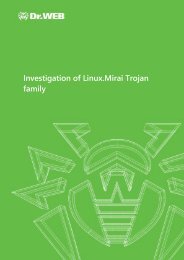y5qa5B
y5qa5B
y5qa5B
Create successful ePaper yourself
Turn your PDF publications into a flip-book with our unique Google optimized e-Paper software.
ASERT Threat Intelligence Report 2016-03: The Four-Element Sword Engagement<br />
Conclusion <br />
Threat actors using similar exploit code are launching or continuing a variety of campaigns (termed as an <br />
“engagement” herein, where an engagement is an offensive action within a larger campaign context) aimed at <br />
targets such as the Tibetan community, Hong Kong and Taiwanese media, and Asian human rights workers. <br />
Due to the easy delivery of RTF files as attachments and the observation of numerous spear phish samples <br />
which reveal precise targeting and timelines, it is likely that spearphish was the primary vector of choice for <br />
most or all of the targeted exploitation scenarios profiled herein. The RTF files observed herein contained up <br />
to four unique exploits for various versions of Office. It is hypothesized that a similar builder kit – which we’ve <br />
named the Four Element Sword Builder -‐ is involved in the creation of these malicious documents, however <br />
future work is required to precisely classify the Four Element Sword builder with respect to crimeware and <br />
APT activity. In the case of the APT oriented threat scenarios profiled herein, anywhere from 2-‐4 of the <br />
exploits were typically observed. In the case of the cybercrime activities that will be profiled in a separate <br />
forthcoming document, 2-‐3 of these exploits were typically observed. <br />
All of the exploit code observed deals with older vulnerabilities that have been patched. However, considering <br />
the target populations at hand, it is possible that older systems may still be in use. Once APT actors gain a <br />
toehold inside an organization, past history shows that it’s just a matter of time before lateral movement and <br />
further exploitation scenarios will unfold to implement the actors actions on objectives. In the case of the <br />
Tibetan community, which has been under attack for years, there have been awareness campaigns designed <br />
to reduce risk by implementing special controls and procedures around dealing with attachments. Recently <br />
published documents by other security research organizations have revealed that actors have evolved to <br />
newer methods in their ongoing efforts to stay beneath the radar. <br />
Regardless of the delivery method, the malware profiled herein are active threats likely deployed in numerous <br />
other scenarios by this, or by other groups of actors. While older exploit code may be a threat to some <br />
populations and not to others, the weaponization of other vulnerabilities is likely taking place and such <br />
malware can easily become a payload in such a case, making all analytic and detective insight of the malicious <br />
code of relevance for defenders in the global defensive sphere. <br />
46 Proprietary and Confidential Information of Arbor Networks, Inc.




